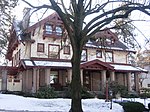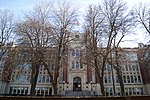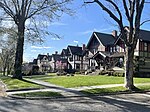The Marycliff-Cliff Park Historic District is a historic residential area in the Cliff/Cannon neighborhood of Spokane, Washington, located immediately uphill from the city's downtown core, listed on the National Register of Historic Places (NRHP). The district is made up of two distinct but connected areas, the Marycliff section located at the base of a basalt cliff and south of Seventh Avenue, and the Cliff Park section located atop the cliff and north of 14th Avenue. Encroachment from the nearby city center has changed the nature of the Marycliff section over the decades. Of the palatial homes built in the late 1800s in the area, all have either been converted to commercial or public use or razed to make way for new development, though there are still a number of properties that are intact and reflect the historic nature of the area. The Cliff Park section retains its original residential character and historic nature, with only 11 properties listed as intrusive among the 118 properties in the area.Built between 1889 and 1941, the historic district is home to numerous architectural styles. Examples of Jacobethan Revival, Georgian Revival, Bungalow, International Style and Spanish Colonial Revival structures can be found in the district. There are a handful of modern intrusions in the area, including the Kenneth and Edna Brooks house built in 1956, which was listed individually on the NRHP on its own merit in 2004. The property is interesting as it is considered an intrusion to the historic district, but historic enough on its own nonetheless to have been listed on the NRHP.The historic district's location along and atop a cliff overlooking the city center played a prominent role in its development. Wealthy residents in the then nascent city of Spokane built mansions in the Browne's Addition neighborhood, along flat land just west of downtown. When space began to run out there, construction of homes for wealthy and prominent residents shifted to the area south of the city center in what is now the Marycliff area of the district, and later up the cliff to the Cliff Park section. Numerous high-profile architects designed homes in the district, including Kirtland Cutter, who built homes along Cliff Drive to resemble scaled down versions of English country manors. Other architects including Waterhouse & Price, Karl Malmgren, Albert Held and G.A. Pehrson, among others, designed homes in the district.












